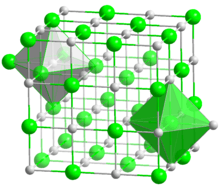Barium sulfide
 | |
| Identifiers | |
|---|---|
| 21109-95-5 | |
| 3D model (Jmol) | Interactive image |
| ChEBI | CHEBI:32590 |
| ChemSpider | 5256933 |
| ECHA InfoCard | 100.040.180 |
| EC Number | 244-214-4 |
| PubChem | 6857597 |
| |
| |
| Properties | |
| BaS | |
| Molar mass | 169.39 g/mol |
| Density | 4.25 g/cm3 [1] |
| Melting point | 1,200 °C (2,190 °F; 1,470 K) |
| Boiling point | decomposes |
| 2.88 g/100 mL (0 °C) 7.68 g/100 mL (20 °C) 60.3 g/100 mL (100 °C) | |
| Solubility | insoluble in alcohol |
| Refractive index (nD) |
2.155 |
| Structure | |
| Halite (cubic), cF8 | |
| Fm3m, No. 225 | |
| Octahedral (Ba2+); octahedral (S2−) | |
| Hazards | |
| EU classification (DSD) |
Harmful (Xn) Dangerous for the environment (N) |
| R-phrases | R20/22, R31, R50 |
| S-phrases | (S2), S28, S61 |
| NFPA 704 | |
| Related compounds | |
| Other anions |
Barium oxide |
| Other cations |
Magnesium sulfide Calcium sulfide Strontium sulfide |
| Except where otherwise noted, data are given for materials in their standard state (at 25 °C [77 °F], 100 kPa). | |
| | |
| Infobox references | |
Barium sulfide is the inorganic compound with the formula BaS. BaS is an important precursor to other barium compounds including BaCO3 and the pigment lithopone, ZnS/BaSO4.[2] Like other chalcogenides of the alkaline earth metals, BaS is a short wavelength emitters for electronic displays.[3] It is colorless, although like many sulfides, it is commonly obtained in impure colored forms.
Discovery, production, properties
BaS was prepared by Vincentius (or Vincentinus) Casciarolus (or Casciorolus, 1571-1624) via reduction of BaSO4 (available as the mineral barite).[4] It is currently manufactured by an improved version of Casciarolus's process using coke in place of flour. This kind of conversion is called a carbothermic reaction:
- BaSO4 + 2 C → BaS + 2 CO2
The phosphorescence of the material made by Casciarolus made it a curiosity and various alchemists and chemists made experiments with the material which was known as Lapis Boloniensis, Chrysolapis or bologna stone.[5][6][7]
Andreas Sigismund Marggraf showed that calcite and gypsum were not very suitable for the production of the bologna stone, but a special heavy fluorspar, in the end he concluded that calcium sulfate is the material from which the bologna stone is made.[8] Recent investigations have shown that naturally occurring impurities of copper in the barium sulfide produced from barium sulfate deposits near Bologna are the likely cause of the phosphorescence.[9]
BaS crystallizes with the NaCl structure, featuring octahedral Ba2+ and S2− centres.
Safety
BaS is quite poisonous, as are related sulfides, such as CaS, which evolve toxic hydrogen sulfide upon contact with water.
References
- ↑ Lide, David R., ed. (2006). CRC Handbook of Chemistry and Physics (87th ed.). Boca Raton, FL: CRC Press. ISBN 0-8493-0487-3.
- ↑ Holleman, A. F.; Wiberg, E. "Inorganic Chemistry" Academic Press: San Diego, 2001. ISBN 0-12-352651-5.
- ↑ Vij, D. R.; Singh, N. "Optical and electrical properties of II-VI wide gap semiconducting barium sulfide" Proceedings of SPIE (1992), 1523 (Conf. Phys. Technol. Semicond. Devices Integr. Circuits, 1992), 608-12.
- ↑ F. Licetus, Litheosphorus, sive de lapide Bononiensi lucem in se conceptam ab ambiente claro mox in tenebris mire conservante, Utini, ex typ. N. Schiratti, 1640. See http://www.chem.leeds.ac.uk/delights/texts/Demonstration_21.htm
- ↑ "Lapis Boloniensis". www.zeno.org.
- ↑ Lemery, Nicolas (1714). Trait℗e universel des drogues simples.
- ↑ Ozanam, Jacques; Montucla, Jean Etienne; Hutton, Charles (1814). Recreations in mathematics and natural philosophy ..
- ↑ Marggraf, Andreas Sigismund (1767). Chymische Schriften.
- ↑ Lastusaari, Mika; Laamanen, Taneli; Malkamäki, Marja; Eskola, Kari O.; Kotlov, Aleksei; Carlson, Stefan; Welter, Edmund; Brito, Hermi F.; Bettinelli, Marco; Jungner, Högne; Hölsä, Jorma (2012). "The Bologna Stone: history's first persistent luminescent material". European Journal of Mineralogy. 24 (5): 885–890. doi:10.1127/0935-1221/2012/0024-2224. ISSN 0935-1221.
